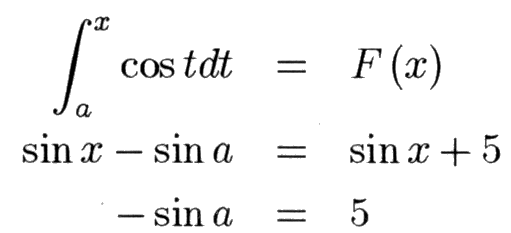

It is a beautiful Spring morning. You are feeling wonderful, because you have just been to the most exciting Calculus class yet. You've learned the Fundamental theorem of Calculus, the result that shows that the two major concepts you've learned so far are actually related. You really should go to your Chemistry class, but you are far too excited to sit still. So you go to the top of your favorite hill, and yell out "I know the Fundamental Theorem of Calculus! Hoo Hah!''
The crowd that has gathered applauds you. Except for one wild-eyed hungry looking stranger. He just says, "The fundamental theorem of calculus. Feh. Who needs it?''
The crowd looks up at you, to see how you will respond to this challenge. You say, "None of your tomfoolery today, my friend. Surely you cannot doubt the veracity of the cornerstone upon which the calculus rests.''
The stranger takes a small easel out of his trenchcoat, and unfolds a large chalkboard. He starts to speak and write:
"Let F(x) be a specific antiderivative of f(x),
i.e. ![]()
then, by the fundamental theorem of calculus we can
write  "
"
"That's actually in my textbook," you say. "Go on."
"So look at this. Let F(x) = sin x + 5, and
f(x) = cos x. Clearly ![]() , so don't go denying it. Now, The
fundamental theorem of calculus then says we can write the following:
, so don't go denying it. Now, The
fundamental theorem of calculus then says we can write the following:

Which can't be done, by gum! Lies! Lies!'' shouts the wild eyed stranger.
The crowd stares at you. Is he correct? Should Newton have stuck to minding the London mint? Should Leibniz have stayed a librarian at Wolfenbuettel? Or is there a chance, however remote, that the stranger made a mistake in his reasoning? You know the drill: Find the error.
Back to Find The Error!
Go to Doug Shaw's Professorial page
Copyright 2001 by Douglas Shaw
Doug Code: pimmu wimi'p kpbcbk nksfpkj bi nkotwfnpk lk rcxuknp lcb xinhkj im qop rcpb hctvcogm, hrcotomg lcb im lkon omyiopk lku hrkcnru pcoe lku xknk "vni-wimi" -jifg pqcx
;